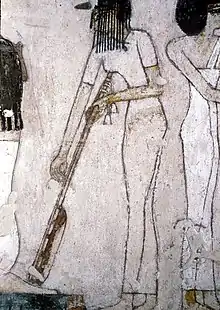Keleli
The keleli is a lute of the Teda people of Tibesti, Republic of Chad.[1][2]

The instrument consists of a round bowl covered with camel, goat or zebra-hide soundboard, and a neck to support the strings.[1][2]
The instrument is built by individuals for themselves.[2] Children lean to play by imitating adults.[2]
Construction
The keleli is a half-spike lute, in which the end of the neck pokes out though the soundboard,[1] as on a xalam. This is one of two styles common to the spike lutes. The other common style is a full spike lute, in which the neck of the instrument goes through two opposite sides of a bowl-shaped soundbox as on a gurmi.[3]

The lute has round soundbox, about 20 inches across, made from a gourd, carved from wood or fashioned from an enamel bowl or metal bowl.[1] The skin soundboard is placed raw over the bowl's opening and tied underneath with thongs.[2] When it dries, it tightens, becoming resonant like a drumhead.[2] The died hide is shaved with a knife.[2]
It is strung with two or three strings, traditionally, strings made from goat sinew.[1] Today nylon strings are common.[1] The bridge is a length of a stick laid on the soundboard next to a soundhole.[1] The strings coming from the neck pass over it and down through the soundhole into the bowl, to attach to the butt of the neck.[1] The soundhole is about 30mm tall by 50mm wide.[2]
Strings are tied to tuning rings or straps on the neck, rather than using tuning pegs;[1] the system is ancient, the tradition found as far back as Ancient Egypt. Another trait similar to ancient Egypt is the manner in which the neck goes though a hole in the top of the soundboard and run under it until it reaches another hole, thus being threaded into the soundboard.[1][2] The end of the stick is exposed at a soundhole near the bowls end.[1]
Tuning and playing
For a two string instrument, the strings are tuned about a third apart.[2] For a three-string instrument, the third string (chanterelle) is turned an octave above the lowest-note string.[2]
The instrument is played by men and boys, starting as children until they reach their mid-forties.[2] There is a set repertoire of music for the instrument, usually only instrumental, but sometimes with "bourdon-like humming in the letter zzz, or a low, quiet whispering of a text."[2]
Similar instruments
The keleli is very similar to another Teda lute called the kiiki.[4] The main difference between the two is that the kiiki is strung with only one string (made of 12 srands of horsehair) and is bowed instead of plucked.[4] Each lute, plucked and bowed, may be converted to the other by changing strings.[4]
- chegeni, Kanembu people, two strings
- chegeni, Daza people, two strings with additional short drone string (as on banjo and akonting).
References
- Monique Brandily (8 December 2014). "Keleli". Grove Music Online. doi:10.1093/gmo/9781561592630.article.L2232561.
- "Keleli". DEKKMMA project (Digitalisatie van het Etnomusicologisch Klankarchief van het Koninklijk Museum voor Midden-Afrika / Digitization of the Ethnomusicological Sound Archive of the Royal Museum for Central Africa). Retrieved 22 May 2023.
- Shlomo Pestcoe; Greg C. Adams (2018). "3 List of West African Plucked Spike Lutes". In Robert B. Winans (ed.). Banjo Roots and Branches. Urbana, Illinois: University of Illinois Press. p. 47.
- "Kiiki". DEKKMMA project (Digitalisatie van het Etnomusicologisch Klankarchief van het Koninklijk Museum voor Midden-Afrika / Digitization of the Ethnomusicological Sound Archive of the Royal Museum for Central Africa). Retrieved 22 May 2023.